
FAIR is a non-profit organization dedicated to providing well-documented answers to criticisms of the doctrine, practice, and history of The Church of Jesus Christ of Latter-day Saints.
m (RogerNicholson movió la página Libro de Mormón:Arte de guerra a El Libro de Mormón/Arte de guerra) |
(m) |
||
| Línea 1: | Línea 1: | ||
{{ | {{Artículos FairMormon copyright}} | ||
{{título del recurso|Arte de guerra en El Libro de Mormón}} | |||
==Armor== | ==Armor== | ||
| Línea 5: | Línea 7: | ||
<blockquote>19 And when the armies of the Lamanites saw that the people of Nephi, or that Moroni, had prepared his people with [[#Breastplates | breastplates]] and with [[#Arm_shields|arm–shields]], yea, and also shields to defend their heads, and also they were dressed with [[#Quilted_armor|thick clothing]]—[http://scriptures.lds.org/alma/43/19#19 Alma 43:19]</blockquote> | <blockquote>19 And when the armies of the Lamanites saw that the people of Nephi, or that Moroni, had prepared his people with [[#Breastplates | breastplates]] and with [[#Arm_shields|arm–shields]], yea, and also shields to defend their heads, and also they were dressed with [[#Quilted_armor|thick clothing]]—[http://scriptures.lds.org/alma/43/19#19 Alma 43:19]</blockquote> | ||
===Arm shields=== | |||
[[Image:Arm_shield_WiBoM01.jpg|thumb|none|"Mayan “arm shield”, from Stela 17, Dos Pilas, Tetexbatun, Guatemala, Around A.D. 733"; from William J. Hamblin, “Armor in the Book of Mormon", p. 415; in ''Warfare in the Book of Mormon'', edited by Stephen D. Ricks & William J. Hamblin, (Provo, Utah: Deseret Book Co. and FARMS, 1990). ''Note that this image post-dates the Nephite period.'']] | |||
===Breastplates=== | |||
[[Image:Pectoral_WiBoM01.jpg|thumb|none|"Mayan headdress and “pectoral” [chest or breastplate] hung or attached around the neck. Stela 16, Dos Pilas, Tetexbatun, Guatemala, Around A.D. 733. William J. Hamblin, “Armor in the Book of Mormon", p. 414; in ''Warfare in the Book of Mormon'', edited by Stephen D. Ricks & William J. Hamblin, (Provo, Utah: Deseret Book Co. and FARMS, 1990).''Note that this image post-dates the Nephite period.'']] | |||
===Quilted armor=== | ===Quilted armor=== | ||
This description matches Mesoamerican quilted armor: | This description matches Mesoamerican quilted armor: | ||
=== | {| valign="top" border="0" style="width:50%" | ||
[[Image: | | | ||
[[Image:Quilted_armor_Metropolitan.jpg|thumb|none|"The garment worn by this figure is believed to represent the quilted armor worn by warriors, but the elaboration of the costume and its accoutrements suggest a figure of high rank and noble status." Costumed Figure, 7th–8th century -- Mexico; Maya Ceramic, pigment; H. 11 17/32 in. (29.3 cm) (1979.206.953) – [http://www.metmuseum.org Metropolitan Museum of Art] Note the pectoral ("breast plate"). ''Note that this figure post-dates the Nephite period.'']] | |||
|| | |||
[[Image: | [[Image:Quilted_armor_WiBoM01.jpg|thumb|none|From William J. Hamblin, “Armor in the Book of Mormon", p. 413; in ''Warfare in the Book of Mormon'', edited by Stephen D. Ricks & William J. Hamblin, (Provo, Utah: Deseret Book Co. and FARMS, 1990). Note the arm shields and pectoral. ''Note that this figure post-dates the Nephite period.'']] | ||
|} | |||
==Fortifications== | ==Fortifications== | ||
| Línea 26: | Línea 32: | ||
The Book of Mormon's description of fortifications matches those in use in Mesoamerica. Multiple sites have been found; the city of Becan is well-known: | The Book of Mormon's description of fortifications matches those in use in Mesoamerica. Multiple sites have been found; the city of Becan is well-known: | ||
[[Image:Becan_1.jpg | {| valign="top" border="0" style="width:100%" | ||
|- | |||
[[Image:Becan_2.jpg | | | ||
[[Image:Becan_1.jpg|thumb|200px|none|The moat at Bécan in the Yucatan is 16 meters wide, and covers a distance of 2 kilometers. The enclosed city covers 25 hectares (almost 62 acres). Reconstruction, on-line at http://mayaruins.com/becan.html]] | |||
[[Image:Becan_3.jpg | || | ||
[[Image:Becan_2.jpg|thumb|200px|none|Artist’s rendering of Bécan fortifications [AD 100-250]; From John L. Sorenson, ''Images of Ancient America: Visualizing Book of Mormon Life'' (Provo, Utah: Research Press, 1998), 133 (Andrea Darais, artist).]] | |||
|| | |||
[[Image:Becan_3.jpg|thumb|200px|none|“Bécan” earthworks, fortifications from Early Classic period (250-400 AD) | |||
David L. Webster, ''Defensive Earthworks at Bécan, Campeche, Mexico: Implications for Mayan Warfare'' (New Orleans: Middle American Research Institute, Tulane University, Publication 41, 1976), 3.]] | David L. Webster, ''Defensive Earthworks at Bécan, Campeche, Mexico: Implications for Mayan Warfare'' (New Orleans: Middle American Research Institute, Tulane University, Publication 41, 1976), 3.]] | ||
|| | |||
[[Image:Becan_4.jpg | [[Image:Becan_4.jpg|thumb|200px|none|Note the modern '''highway''' in the upper left corner! [Gives a sense of the scale.] | ||
David L. Webster, ''Defensive Earthworks at Bécan, Campeche, Mexico: Implications for Mayan Warfare'' (New Orleans: Middle American Research Institute, Tulane University, Publication 41, 1976), 3. | David L. Webster, ''Defensive Earthworks at Bécan, Campeche, Mexico: Implications for Mayan Warfare'' (New Orleans: Middle American Research Institute, Tulane University, Publication 41, 1976), 3. | ||
]] | ]] | ||
|} | |||
It should be noted too that the rise of Mesoamerican fortification in the | It should be noted too that the rise of Mesoamerican fortification in the archaeological record matches the introduction of this form of warfare among the Nephites by Captain Moroni in about 72 B.C. (See [http://scriptures.lds.org/alma/49/8#8 Alma 49:8]).The first number indicates "''Definitive''" sites; the second is "''Possible''" sites: | ||
[[Image:Fort_Sites_Mesoamerica.jpg | [[Image:Fort_Sites_Mesoamerica.jpg|thumb|200px|none|John L. Sorenson, "Fortifications in the Book of Mormon Account Compared with Mesoamerican Fortifications" (Table 2, p. 429) in Stephen D. Ricks & William J. Hamblin, (eds), ''Warfare in the Book of Mormon'' (Salt Lake City: Deseret Book, 1990), 425-444. The first number indicates "Definitive" sites; the second is "possible" sites.]] | ||
==Ritual warfare== | ==Ritual warfare== | ||
===Apostate cities=== | ===Apostate cities=== | ||
{{MaxwellInstituteBar | |||
|link=http://publications.maxwellinstitute.byu.edu/fullscreen/?pub=1108&index=5 | |||
|title=The Destruction of Ammonihah and the Law of Apostate Cities | |||
|author=John W. Welch | |||
|publication=Reexploring the Book of Mormon | |||
|date=1992 | |||
|summary=While Alma clearly lacked both the desire and the power to have the city of Ammonihah destroyed by a Nephite military force, and certainly no legal decree was ever issued calling for the extermination of the city, Alma carefully recorded and documented the fact that the inhabitants of Ammonihah had satisfied every element of the crime of being an apostate city. When the justice of God destroyed that city, Alma effectively showed in the record that this fate befell them in accordance with divine law. | |||
}} | |||
{{MaxwellInstituteBar | |||
|link=http://publications.maxwellinstitute.byu.edu/fullscreen/?pub=1108&index=5 | |||
|title=Law and War in the Book of Mormon | |||
|author=John W. Welch | |||
|publication=Warfare in the Book of Mormon | |||
|date=1990 | |||
|summary=At first, law and war appear to be opposites. Especially in the modern experience, wars are thought to be basically extralegal. They break out when law and order break down; rules and conventions can become next to meaningless in the heat and rage of war. On closer examination, however, even war cannot be conducted successfully in a total state of anarchy or chaos. To a greater or lesser extent, all civilizations accept and employ certain laws, rules, customs, rituals, and conventional practices in times of war. In ancient Israel and in the Book of Mormon, this was certainly also the case. | |||
}} | |||
===Oaths taken by warriors=== | ===Oaths taken by warriors=== | ||
{{MaxwellInstituteBar | |||
|link=http://publications.maxwellinstitute.byu.edu/fullscreen/?pub=1108&index=4 | |||
|title=An Oath of Allegiance in the Book of Mormon | |||
|author=Terrence L. Szink | |||
|publication=Warfare in the Book of Mormon | |||
|date=1990 | |||
|summary=An important element in any military endeavor is the loyalty of the soldiers. Obviously, even the most brilliant military tactics will fail if the troops are unfaithful in fulfilling their duty. Often, to instill this loyalty, an oath of allegiance is administered to recruits. The well-known titleof-liberty episode in Alma 46 of the Book of Mormon includes an interesting example of just such an oath. This paper will examine that oath, drawing upon parallels from the ancient Near East for comparison. | |||
}} | |||
{{MaxwellInstituteBar | |||
|link=http://publications.maxwellinstitute.byu.edu/fullscreen/?pub=1382&index=9 | |||
|title=Simile Curses in the Ancient Near East, Old Testament, and Book of Mormon | |||
|author=Mark J. Morrise | |||
|publication=Journal of Book of Mormon Studies | |||
|vol=2 | |||
|num=1 | |||
|date=1993 | |||
|summary=The simile curse is a type of curse that appears in ancient Near Eastern, Old Testament, and Book of Mormon texts. It consists of two parts: (1) an event (e.g., "Just as this wax is burned by fire") and (2) an application of that event to the subject of the curse (e.g., "so shall Arpad be burned"). In ancient Near Eastern texts, simile curses appear in written treaties and were often part of a ritual acted out during a treaty ceremony. In the Old Testament, simile curses appear primarily in prophetic writings as literary devices. In the Book of Mormon, simile curses appear in the context of treaties, religious covenants, and prophecies, and in several instances were acted out. These curses were probably part of the oral tradition of ancient Near Eastern, Old Testament, and Book of Mormon peoples. | |||
}} | |||
{{MaxwellInstituteBar | |||
|link=http://publications.maxwellinstitute.byu.edu/fullscreen/?pub=1110&index=54 | |||
|title=Exemption from Military Duty | |||
|author=John W. Welch | |||
|publication=Reexploring the Book of Mormon | |||
|date=1992 | |||
|summary=The only Book of Mormon group given an exemption from military service was the famous people of Ammon. In repenting of their previous shedding of blood, they had sworn an oath that they would never again take up arms (see Alma 24:11-13). After they arrived in Zarahemla, they were granted an extraordinary exemption from active military duty if they would help to sustain the Nephite armies with provisions (see Alma 27:23-24). Surprisingly, the grant of this exceptional privilege was consistent with ancient Israelite law. | |||
}} | |||
{{MaxwellInstituteBar | |||
|link=http://publications.maxwellinstitute.byu.edu/fullscreen/?pub=1110&index=58 | |||
|title='Holy War' in the Book of Mormon and the Ancient Near East | |||
|author=Stephen D. Ricks | |||
|publication=Reexploring the Book of Mormon | |||
|date=1992 | |||
|summary=In a sense, every conflict in the ancient Near East—as reflected in Egyptian, Babylonian, Assyrian, Hittite, Persian, and Syro-Palestinian texts—was considered to be prosecuted under the divine direction of the gods or of God. War was begun at the command of, or with the approval and aid of, the gods or God. It was generally accompanied by sacrifices, fought by men who were in a state of ritual readiness for conflict, and ended by the victors with thanksgiving and offerings to deity. | |||
}} | |||
{{MaxwellInstituteBar | |||
|link=http://publications.maxwellinstitute.byu.edu/fullscreen/?pub=1108&index=6 | |||
|title='Holy War': The Sacral Ideology of War in the Book of Mormon and in the Ancient Near East | |||
|author=Stephen D. Ricks | |||
|publication=Warfare in the Book of Mormon | |||
|date=1990 | |||
|summary=In a sense, every conflict in the ancient Near East was prosecuted under the direction of the gods or of God. Men began war at the command of, or with the approval and aid of, the gods or of God; sacrifices generally accompanied it, men fought who were in a state of ritual readiness for combat, and the victors ended the conflict with thanksgiving and offerings to deity. | |||
}} | |||
{{MaxwellInstituteBar | |||
|link=http://publications.maxwellinstitute.byu.edu/fullscreen/?pub=1110&index=59 | |||
|title=Symbolic Action as Prophetic Curse | |||
|author=Donald W. Parry | |||
|publication=Reexploring the Book of Mormon | |||
|date=1992 | |||
|summary=At one point in his ministry, Isaiah was instructed by the Lord to remove his garment and shoes and walk "naked [like a slave, without an upper garment] and barefoot" among the people. Isaiah's action was to be a sign, for as Isaiah walked like a slave, even so would the Egyptians become slaves to the Assyrians (Isaiah 20:2-4). This prophetic symbolic action by Isaiah represented a prophetic curse that destruction and ruin would come upon the Egyptians. | |||
}} | |||
==Seasonality of Warfare== | ==Seasonality of Warfare== | ||
{{MaxwellInstituteBar | |||
|link=http://publications.maxwellinstitute.byu.edu/fullscreen/?pub=1108&index=21 | |||
|title=Seasonality of Warfare in the Book of Mormon and in Mesoamerica | |||
|author=John L. Sorenson | |||
|publication=Warfare in the Book of Mormon | |||
|date=1990 | |||
|summary=When we carefully examine the accounts of wars in the middle portion of the Nephite record, we find that military action did not take place at random throughout the calendar year but at particular times. Whatever realistic scene we assume for the Nephite lands, we would expect to find a similar seasonal pattern in that area's secular historical sources. I consider Mesoamerica (central and southern Mexico and northern Central America) to have been the scene of the Nephite conflicts, but whatever plausible location one chooses will lie in the tropics because, among other reasons, only in those areas are there feasible isthmuses located that could correspond to the "narrow neck of land" of the Nephites. Everywhere in those latitudes, war was normally carried on by the pre-Columbian inhabitants during a short annual period. This paper investigates the evidence for seasonality of warfare in the Book of Mormon account and compares it with what is currently known about the timing of warfare in Mesoamerica. | |||
}} | |||
A fascinating issue on climate is the seasons of war described in the Book of Mormon, mostly between [http://scriptures.lds.org/en/alma/9 Alma 9] and [http://scriptures.lds.org/en/alma/47 Alma 47]. Several examples provide specific months and days of the battle (e.g., [http://scriptures.lds.org/en/alma/16/1#1 Alma 16:1]). Many others indicate the general time of year (e.g., [http://scriptures.lds.org/en/alma/44/22-24#22 Alma 44:22–24]). In over 30 places, war action is described as taking place near the end or beginning of the year. Sorenson has compiled information from the text about the month of the year various military skirmishes are mentioned. Almost all occur between the 11th and 3rd months, with a small number reported in the 4th, 5th, and 10th months, and none mentioned in the 6th through 9th months.{{ | A fascinating issue on climate is the seasons of war described in the Book of Mormon, mostly between [http://scriptures.lds.org/en/alma/9 Alma 9] and [http://scriptures.lds.org/en/alma/47 Alma 47]. Several examples provide specific months and days of the battle (e.g., [http://scriptures.lds.org/en/alma/16/1#1 Alma 16:1]). Many others indicate the general time of year (e.g., [http://scriptures.lds.org/en/alma/44/22-24#22 Alma 44:22–24]). In over 30 places, war action is described as taking place near the end or beginning of the year. Sorenson has compiled information from the text about the month of the year various military skirmishes are mentioned. Almost all occur between the 11th and 3rd months, with a small number reported in the 4th, 5th, and 10th months, and none mentioned in the 6th through 9th months.{{ref|sor1}} Why this pattern? | ||
Interestingly, the text also makes reference to cultivation of food a number of times in the 4th through 9th months. The problem of getting food to the troops is mentioned as a concern mainly in the twelfth through second months. Thus it seems that the harvest may have been in months 10 through 12. The Nephite "agricultural year" seems, then, to | Interestingly, the text also makes reference to cultivation of food a number of times in the 4th through 9th months. The problem of getting food to the troops is mentioned as a concern mainly in the twelfth through second months. Thus it seems that the harvest may have been in months 10 through 12. The Nephite "agricultural year" seems, then, to proceed like this: | ||
* Cultivation of fields: months 4-9 | * Cultivation of fields: months 4-9 | ||
| Línea 73: | Línea 156: | ||
* the Book of Mormon shows remarkable accuracy (and internal consistency) in dealing with the ancient relationship between agriculture and warfare. | * the Book of Mormon shows remarkable accuracy (and internal consistency) in dealing with the ancient relationship between agriculture and warfare. | ||
But how do Nephite months correspond to ours? In Mesoamerica, May though September is the best time for growing crops (heat and moisture are most available). October through April is fairly dry. We also know that before Columbus, military campaigns in Central America occurred mainly between late October and February (again, farmers were then free of agricultural duties and food could be gathered—or seized as plunder). Likewise, soggy land from heavy rains would be drier and more passable (and made living in tents easier). These considerations lead Sorenson and others to conclude that the Nephite year may have begun in late December, perhaps with the winter solstice (Dec. 21/22), as did many other ancient peoples.{{ | But how do Nephite months correspond to ours? In Mesoamerica, May though September is the best time for growing crops (heat and moisture are most available). October through April is fairly dry. We also know that before Columbus, military campaigns in Central America occurred mainly between late October and February (again, farmers were then free of agricultural duties and food could be gathered—or seized as plunder). Likewise, soggy land from heavy rains would be drier and more passable (and made living in tents easier). These considerations lead Sorenson and others to conclude that the Nephite year may have begun in late December, perhaps with the winter solstice (Dec. 21/22), as did many other ancient peoples.{{ref|sor2}} | ||
===Different from Joseph Smith's World=== | ===Different from Joseph Smith's World=== | ||
| Línea 84: | Línea 167: | ||
==Secret Combinations== | ==Secret Combinations== | ||
{{MaxwellInstituteBar | |||
|link=http://publications.maxwellinstitute.byu.edu/fullscreen/?pub=1108&index=15 | |||
|title=Secret Combinations, Warfare, and Captive Sacrifice in Mesoamerica and the Book of Mormon | |||
|author=Bruce W. Warren | |||
|publication=Warfare in the Book of Mormon | |||
|date=1990 | |||
|summary=The source of secret combinations in the Book of Mormon is given in the following passage: Satan "did plot with Cain, that if he would murder his brother Abel it should not be known unto the world. And he did plot with Cain and his followers from that time forth. And also it is that same being who put it into the hearts of the people to build a tower sufficiently high that they might get to heaven. And it was that same being who led on the people who came from that tower into this land; who spread the works of darkness and abominations over all the face of the land, until he dragged the people down to an entire destruction, and to an everlasting hell" (Helaman 6:27-28). | |||
}} | |||
==Tactics== | ==Tactics== | ||
{{Main|/Tactics|l1=Tactics in Book of Mormon warfare}} | |||
==Strategy== | |||
{{Main|/Strategy|l1=Strategy in Book of Mormon warfare}} | |||
==Weapons== | ==Weapons== | ||
===Swords=== | ===Swords=== | ||
{{Main|Book of Mormon and warfare/Swords}} | |||
{{MaxwellInstituteBar | |||
|link=http://publications.maxwellinstitute.byu.edu/fullscreen/?pub=1108&index=15 | |||
|title=Swords in the Book of Mormon | |||
|author=William J. Hamblin, A. Brent Merrill | |||
|publication=Warfare in the Book of Mormon | |||
|date=1990 | |||
|summary=The Book of Mormon mentions the sword 156 times, more than any other weapon. For the sake of discussion, we have divided its usage into two categories: literary or metaphorical and military-technical. We have classified seventy-eight instances as metaphorical and seventy-eight as technical (though many occurrences are ambiguous and could fall in either category). There are four major types of sword metaphors used in the Book of Mormon: fighting or warfare in general, violent death, military vigilance, and divine power. The book metaphorically describes fighting in battle with eighteen different sword phrases, violent death with seven major metaphors, military preparedness with two phrases, and divine power with five metaphors. | |||
}} | |||
===Cimeters / Scimiters === | ===Cimeters / Scimiters === | ||
{{MaxwellInstituteBar | |||
|link=http://publications.maxwellinstitute.byu.edu/fullscreen/?pub=1396&index=7 | |||
|title=Swords and "Cimeters" in the Book of Mormon | |||
|author=Matthew Roper | |||
|publication=Journal of Book of Mormon Studies | |||
|vol=8 | |||
|num=1 | |||
|date=1999 | |||
|summary=Most readers of the Book of Mormon have some idea of what a sword may have looked like, but what were "cimeters"? Even a dictionary will not help with this term. Yet, as we shall see, even our preconceptions about "swords" need clarifying. The English expression sword in the King James Version of the Bible ought to be enough to caution us about easy assumptions, since it is used to translate Hebrew terms as varied as baraq, "lightning" (a metaphor); šelah, "javelin" or "dart"; petihah, "dagger"; resah, "murder" (metaphoric); and hereb, "short sword" or "knife." | |||
}} | |||
=== | {{MaxwellInstituteBar | ||
|link=http://publications.maxwellinstitute.byu.edu/fullscreen/?pub=1108&index=16 | |||
= | |title=Scimitars, Cimeters! We Have Scimitars! Do We Need Another Cimeter? | ||
|author=Paul Y. Hoskisson | |||
|publication=Warfare in the Book of Mormon | |||
|date=1990 | |||
|summary=Some critics have termed the presence of scimitars in the text of the Book of Mormon anachronistic. They base their claim on the mistaken assumption that scimitars did not exist in the pre-Islamic Old World and therefore could not have appeared among Book of Mormon peoples who claim an Old World nexus with Iron Age II Palestine.3 This assumption is based no doubt on one or more of the following considerations: (1) the scimitar is not mentioned earlier than the sixteenth century in English texts;4 (2) the Persian word samsir probably provided the etymon for the English word;5 and (3) the mistaken assumption that the period from A.D. 1000 to 1200 saw the "perfection of the Moslem scimitar."6 None of these observations asserts the presence or absence of scimitars in pre-Islamic times. Any arguments to the contrary based on these observations are simply arguments from silence and in this case would result in false conclusions. | |||
}} | |||
=== | {{MaxwellInstituteBar | ||
|link=http://publications.maxwellinstitute.byu.edu/fullscreen/?pub=1108&index=17 | |||
|title=Notes on the Cimeter (Scimitar) in the Book of Mormon | |||
|author=William J. Hamblin, A. Brent Merrill | |||
|publication=Warfare in the Book of Mormon | |||
|date=1990 | |||
|summary=One of the earliest Mesoamerican candidates for the Book of Mormon scimitar is found in a Late Pre-Classic sculpture that shows a warrior holding in one hand a macuahuitl2 and in the other a strange curved weapon (see fig. 3, p. 339 in chapter 15). It is impossible to say for certain what this item is supposed to represent. However, a similar weapon is known in India — the haladi.3 Note that this warrior holds both a macuahuitl sword and a curved weapon just as Zerahemnah is described in the Book of Mormon as being armed with. | |||
}} | |||
=== | ===Bows and Arrows=== | ||
{{MaxwellInstituteBar | |||
|link=http://publications.maxwellinstitute.byu.edu/fullscreen/?pub=1108&index=18 | |||
=== | |title=The Bow and Arrow in the Book of Mormon | ||
|author=William J. Hamblin | |||
|publication=Warfare in the Book of Mormon | |||
|date=1990 | |||
|summary=After the sword, the bow is the second most frequently mentioned weapon in the Book of Mormon. Bows are mentioned twenty-two times, arrows twenty-six. In fourteen cases the bow and arrow are mentioned together; in eight cases, the bow is mentioned alone; in twelve, the arrow alone. In most cases, the bow is simply mentioned as a weapon with no additional details. However, several significant incidents give some indication of the nature and use of the Book of Mormon bow. | |||
}} | |||
=={{Endnotes label}}== | |||
#{{note|sor1}} {{Rediscovering|author=John Sorenson|article=Seasons of War, Seasons of Peace in the Book of Mormon|start=249 | end=256}} | |||
#{{note|sor2}} {{Rediscovering|author=John Sorenson|article=Seasons of War, Seasons of Peace in the Book of Mormon|start=249 | end=256}} | |||
Book of Mormon armor does not match the type of armor that Joseph Smith would have been familiar with, nor does it reflect European styles of armor:
19 And when the armies of the Lamanites saw that the people of Nephi, or that Moroni, had prepared his people with breastplates and with arm–shields, yea, and also shields to defend their heads, and also they were dressed with thick clothing—Alma 43:19
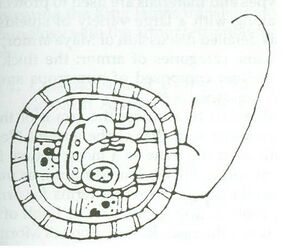
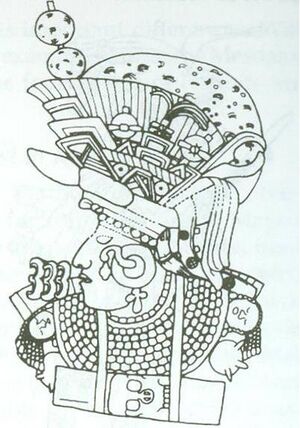
This description matches Mesoamerican quilted armor:
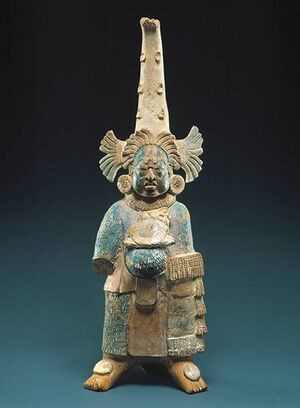 |
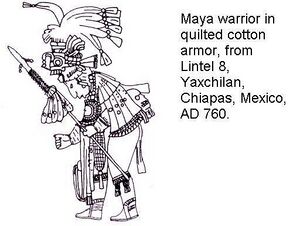 |
The Book of Mormon's description of fortifications matches those in use in Mesoamerica. Multiple sites have been found; the city of Becan is well-known:
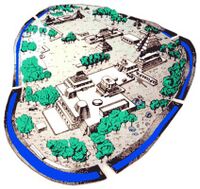 |
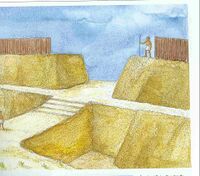 |
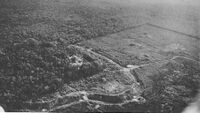 |
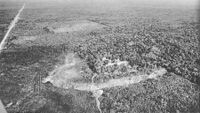 |
It should be noted too that the rise of Mesoamerican fortification in the archaeological record matches the introduction of this form of warfare among the Nephites by Captain Moroni in about 72 B.C. (See Alma 49:8).The first number indicates "Definitive" sites; the second is "Possible" sites:
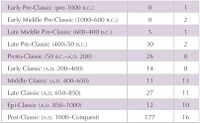
{{{publicación}}}
{{{publicación}}}
{{{publicación}}}
{{{publicación}}}
{{{publicación}}}
{{{publicación}}}
{{{publicación}}}
{{{publicación}}}
{{{publicación}}}
A fascinating issue on climate is the seasons of war described in the Book of Mormon, mostly between Alma 9 and Alma 47. Several examples provide specific months and days of the battle (e.g., Alma 16:1). Many others indicate the general time of year (e.g., Alma 44:22–24). In over 30 places, war action is described as taking place near the end or beginning of the year. Sorenson has compiled information from the text about the month of the year various military skirmishes are mentioned. Almost all occur between the 11th and 3rd months, with a small number reported in the 4th, 5th, and 10th months, and none mentioned in the 6th through 9th months.[1] Why this pattern?
Interestingly, the text also makes reference to cultivation of food a number of times in the 4th through 9th months. The problem of getting food to the troops is mentioned as a concern mainly in the twelfth through second months. Thus it seems that the harvest may have been in months 10 through 12. The Nephite "agricultural year" seems, then, to proceed like this:
This leads to several insights:
But how do Nephite months correspond to ours? In Mesoamerica, May though September is the best time for growing crops (heat and moisture are most available). October through April is fairly dry. We also know that before Columbus, military campaigns in Central America occurred mainly between late October and February (again, farmers were then free of agricultural duties and food could be gathered—or seized as plunder). Likewise, soggy land from heavy rains would be drier and more passable (and made living in tents easier). These considerations lead Sorenson and others to conclude that the Nephite year may have begun in late December, perhaps with the winter solstice (Dec. 21/22), as did many other ancient peoples.[2]
The Book of Mormon's consistent representation of the seasonality of Mesoamerican warfare bodes poorly for the theory that Joseph Smith wrote the Book of Mormon. A significant battle scene (one in which the long-term survival of the Nephite nation might have been at stake) is described in Alma 51: at the end of the year—around December. After heavy fighting and major marches, both sides were very tired because of their "labors and heat of the day." This takes place on the east coast, "in the borders on the beach by the seashore" (Alma 51:32).
In Mesoamerica, at this season, the rain-swollen rivers have subsided, but the east region (which would correspond to the Isthmus of Tehuantepec area under the limited geography model) is still rather wet, low, and hot. The hottest weather was still months away, but down on the coast it was hot and muggy enough to contribute to the fatigue of the rapidly traveling troops.
Alma 51: shows that the land of the Book of Mormon peoples was not a cold, snow-covered place in winter, as upstate New York was for young Joseph Smith. If Joseph created the book based on what he knew, he would have had fighting occur in the summer, not during winter. The internal consistency of many passages dealing with war during the proper season of war for Mesoamerica is also remarkable—and has not been noted or recognized until the late twentieth century. Though it is a minor point in the text, the geographical and climatic information provided fits and makes sense. It must be considered as one of the many "mundane" but powerful evidences for authenticity.
{{{publicación}}}
{{{publicación}}}
{{{publicación}}}
{{{publicación}}}
{{{publicación}}}
{{{publicación}}}

FAIR is a non-profit organization dedicated to providing well-documented answers to criticisms of the doctrine, practice, and history of The Church of Jesus Christ of Latter-day Saints.
We are a volunteer organization. We invite you to give back.
Donate Now